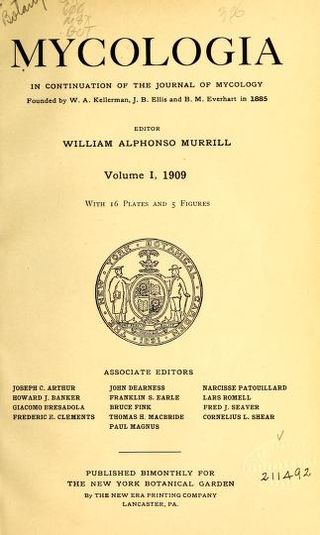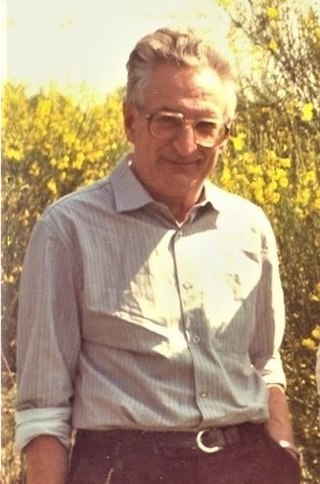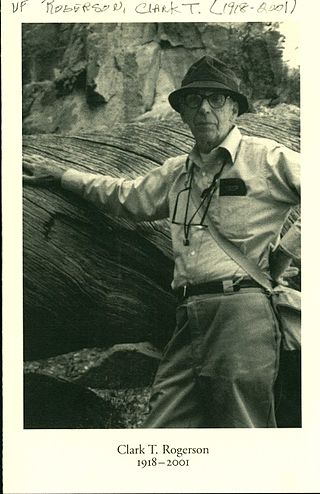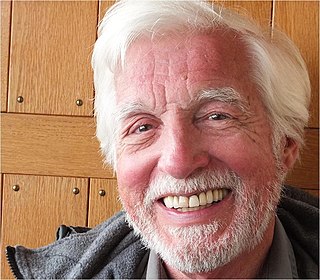Related Research Articles

Mycologia is a peer-reviewed scientific journal that publishes papers on all aspects of the fungi, including lichens. It first appeared as a bimonthly journal in January 1909, published by the New York Botanical Garden under the editorship of William Murrill. It became the official journal of the Mycological Society of America, which still publishes it today. It was formed as a merger of the Journal of Mycology and the Mycological Bulletin. The Mycological Bulletin was known as the Ohio Mycological Bulletin in its first volume.

Meinhard Michael Moser was an Austrian mycologist. His work principally concerned the taxonomy, chemistry, and toxicity of the gilled mushrooms (Agaricales), especially those of the genus Cortinarius, and the ecology of ectomycorrhizal relationships. His contributions to the Kleine Kryptogamenflora von Mitteleuropa series of mycological guidebooks were well regarded and widely used. In particular, his 1953 Blätter- und Bauchpilze [The Gilled and Gasteroid Fungi ], which became known as simply "Moser", saw several editions in both the original German and in translation. Other important works included a 1960 monograph on the genus Phlegmacium and a 1975 study of members of Cortinarius, Dermocybe, and Stephanopus in South America, co-authored with the mycologist Egon Horak.
Roy Edward Halling is an American mycologist.
Margaret Elizabeth Barr Bigelow (1923–2008) was a Canadian mycologist known for her contributions to the Ascomycetes fungi.

Clark Thomas Rogerson,, was an American mycologist. He was known for his work in the Hypocreales (Ascomycota), particularly Hypomyces, a genus of fungi that parasitize other fungi. After receiving his doctorate from Cornell University in 1950, he went on to join the faculty of Kansas State University. In 1958, he became a curator at The New York Botanical Garden, and served as editor for various academic journals published by the Garden. Rogerson was involved with the Mycological Society of America, serving in various positions, including president in 1969. He was managing editor (1958–89) and editor-in-chief (1960–65) of the scientific journal Mycologia.
Harry Morton Fitzpatrick, was an American mycologist. He was professor of mycology at Cornell. He is known for his work on the Phycomycetes. His book on the Lower Fungi was the standard text and reference work on the Phycomycetes. He trained Clark Thomas Rogerson and Richard P. Korf, two prominent mycologists.

Kálmán Géza Vánky was a Hungarian mycologist with Swedish and Hungarian citizenship, who lived in Germany. He was considered to be the worldwide authority on the subject of smut fungi and has dominated the taxonomic study of Ustilaginomycetes for at least the past four decades.
Agathe Louise van Beverwijk was a Dutch mycologist and botanist. She spent most of her career at the Centraalbureau voor Schimmelcultures, where she was director from 1958 until her death in 1963.

Everett Smith Beneke was an American medical mycologist, and professor of microbiology at Michigan State University (1948–1987). Beneke chaired the American Board of Bioanalysis (1968–2004), he lived in Florida and died in 2010 at the age of 91. He made contributions to the field of human mycoses.
Lois Hattery Tiffany (1924–2009) was a mycologist who taught for over 50 years at Iowa State University (ISU) and was known as "Iowa's mushroom lady". She won a number of awards, including becoming the first recipient of both the Mycological Society of America's Weston Award and the Iowa Governor’s Medal for Science Teaching. She published on many different aspects of fungal life, but her special area of research was Iowa's prairie fungi.
Emil Müller was a Swiss mycologist. He specialised in the study of the systematics of the ascomycetes. Müller was the editor of the scientific journal Sydowia for several years, taking over the position after the death of the previous editor and founder, Franz Petrak, in 1973. Müller published more than 200 papers in his scientific career. He was well known in the mycological community for two taxonomic publications co-authored with his colleague J.A. von Arx: Die Gattungen der amerosporen Pyrenomyceten and Die Gattungen der didymosporen Pyrenomyceten.
Everett Stanley Luttrell was an American mycologist and plant pathologist at the University of Georgia's Georgia Experiment Station and main campus.He served as the DW Brooks Distinguished Professor of Plant Pathology at the University of Georgia from in 1978 to 1986. Luttrell was particularly known for his work on the classification of perithecial ascomycetes and Helminthosporium.
Robert W. Lichtwardt was a Brazilian-born American mycologist specializing in the study of arthropod-associated, gut-dwelling fungi (trichomycetes). He is known for his online monograph and interactive keys to trichomycete taxa.
Richard Paul "Dick" Korf was an American mycologist and founding co-editor of the journal Mycotaxon. He was a preeminent figure in the study of discomycetes and made significant contributions to the field of fungal nomenclature and taxonomy. Korf was professor emeritus of mycology at Cornell University and director emeritus of Cornell University's Plant Pathology Herbarium.
Pedro Willem Crous is a South African mycologist and plant pathologist.

Constantine John Alexopoulos was an American mycologist. He was the main author of the landmark book Introductory Mycology, commonly used in mycology and mycology-related courses in undergrad and grad schools around the globe. Introductory Mycology was translated into five languages.

Chester Wilson Emmons was an American scientist, who researched fungi that cause diseases. He was the first mycologist at the National Institutes of Health (NIH), where for 31 years he served as head of its Medical Mycology Section.
Marie Leonore Farr (1927–2014), known as Lennie Farr, was an American mycologist. She was the first woman to be elected president of the Mycological Society of America.

Austria and the North Atlantic Treaty Organization (NATO) have a close relationship. Austria with Ireland, Cyprus and Malta are the only members of the European Union that are not members of NATO. Austria has had formal relations with NATO since 1995, when it joined the Partnership for Peace programme.
References
- ↑ Fitzpatrick, Harry Morton (1944). "The first twelve years of the Mycological Society of America". Mycologia. 44 (1): 1–17. doi:10.1080/00275514.1944.12017526. JSTOR 3754877.
- ↑ "MSA Constitution and Bylaws". Mycological Society of America. Retrieved 23 August 2021.
- ↑ "Mycologia". Mycologia. Taylor & Francis. Retrieved 23 August 2021.